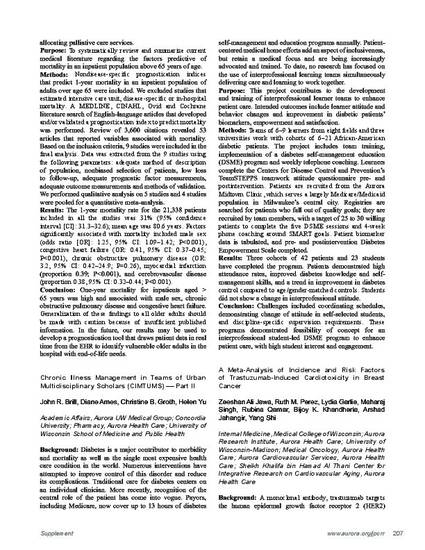
- diabetes,
- self-management education,
- medical students
Background: Diabetes is a major contributor to morbidity and mortality as well as the single most expensive health care condition in the world. Numerous interventions have attempted to improve control of this disorder and reduce its complications. Traditional care for diabetes centers on an individual clinician. More recently, recognition of the central role of the patient has come into vogue. Payors, including Medicare, now cover up to 13 hours of diabetes self-management and education programs annually. Patient-centered medical home efforts add an aspect of inclusiveness, but retain a medical focus and are being increasingly advocated and trained. To date, no research has focused on the use of interprofessional learning teams simultaneously delivering care and learning to work together.
Purpose: This project contributes to the development and training of interprofessional learner teams to enhance patient care. Intended outcomes include learner attitude and behavior changes and improvement in diabetic patients’ biomarkers, empowerment and satisfaction.
Methods: Teams of 6–9 learners from eight fields and three universities work with cohorts of 6–21 African-American diabetic patients. The project includes team training, implementation of a diabetes self-management education (DSME) program and weekly telephone coaching. Learners complete the Centers for Disease Control and Prevention’s TeamSTEPPS teamwork attitude questionnaire pre- and postintervention. Patients are recruited from the Aurora Midtown Clinic, which serves a largely Medicare/Medicaid population in Milwaukee’s central city. Registries are searched for patients who fall out of quality goals; they are recruited by team members, with a target of 25 to 30 willing patients to complete the five DSME sessions and 4-week phone coaching around SMART goals. Patient biomarker data is tabulated, and pre- and postintervention Diabetes Empowerment Scale completed.
Results: Three cohorts of 42 patients and 23 students have completed the program. Patients demonstrated high attendance rates, improved diabetes knowledge and self-management skills, and a trend in improvement in diabetes control compared to age/gender-matched controls. Students did not show a change in interprofessional attitude.
Conclusion: Challenges included coordinating schedules, demonstrating change of attitude in self-selected students, and discipline-specific supervision requirements. These programs demonstrated feasibility of concept for an interprofessional student-led DSME program to enhance patient care, with high student interest and engagement.
Available at: http://works.bepress.com/john-brill/6/
